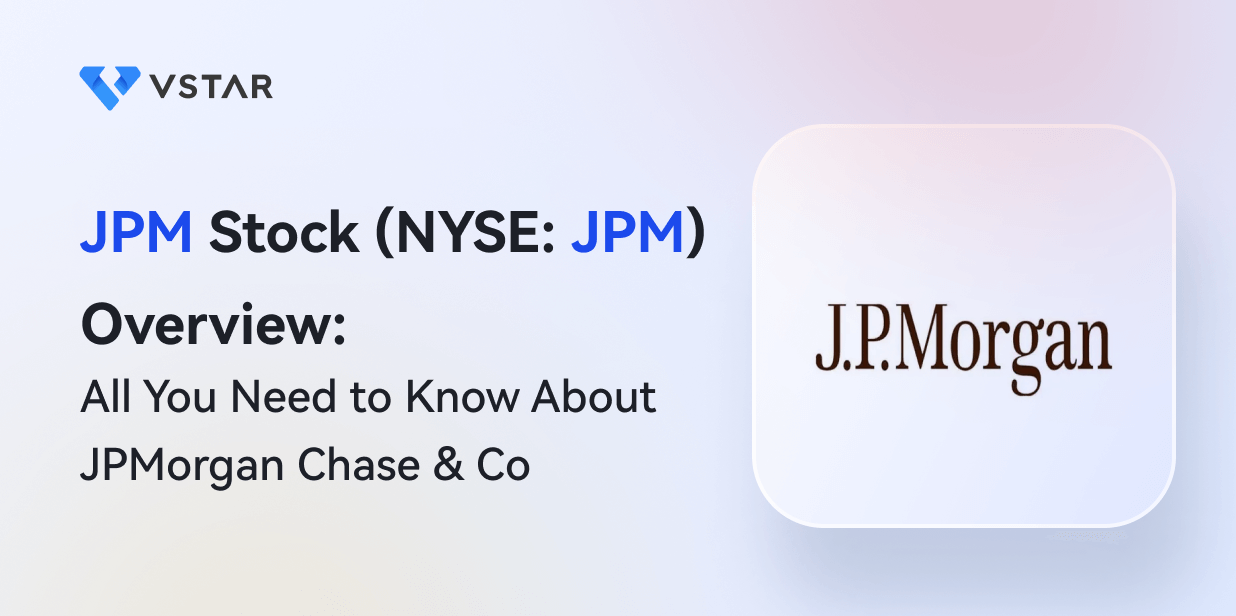When it comes to investment banking and asset management, JPMorgan Chase & Co. remains at the top. Banking on the prestige and achievements accumulated over 200 years, the firm shows no signs of stopping even in the face of the current US banking turmoil.
The investment firm opened up new offices in Mumbai and Bengaluru, India, and beat analysts' expectations for the second quarter. It also snapped up First Republic Bank in a $10.6 billion deal brokered by government regulators and is expanding its customer base by developing its digital banking capabilities. For example, it recently launched its Tap to Pay feature on iPhone allowing merchants to accept contactless payments with their iPhones.
Although JPMorgan is faring better than most banks as the US banking system becomes stable again, it still has to deal with some issues. Cash deposits at JPMorgan fell by $75 billion because customers are demanding higher yields and it lost $1.1 billion in a massive write-off for bad credit card debt. But as the largest bank in the United States, JPMorgan is sturdy enough to withstand short-term challenges and might be the stock you want in your portfolio.
How JPMorgan Chase & Co. Got Started
JPMorgan Chase & Co. is the product of more than 1,200 institutions coming together for 200 years. The firm can be traced back to 1799 when the Manhattan company was founded in New York City by JP Morgan Chase, Alexander Hamilton, and Aaron Burr. At first, it supplied just drinking water to the city but 5 months after it was founded, the Bank of the Manhattan Company was established and it became the second commercial bank in the city. In 1954, it was merged with Chase National Bank to become the Chase Manhattan Bank. JPMorgan & Co was born out of Drexel, Morgan & Co after the firm received a name change following the death of Anthony J. Drexel, one of its founders.

Source: JPMorgan Chase
Later in 2000, Chase Manhattan Bank merged with JPMorgan & Co. as well as asset assumptions from First Republic, Washington Mutual, and Bear Stearns resulting in the present JPMorgan Chase & Co. Other historic banking firms like Manufacturers Hanover, Chemical Bank, Texas Commercial Bank, National Bank of Detroit, Providian Financial, and Great Western Bank.
JPMorgan Chase & Co. is currently located in New York City under the leadership of Jamie Dimon and it is owned largely by institutional investors. Vanguard Group holds the most shares in the company at 9.41% followed by BlackRock Inc and State Street Corp which holds 6.62% and 4.34% respectively. With backing from its investors and a growing customer base, the company has expanded beyond the United States and it now provides services to people across the globe.
Business Model and Services
JPMorgan Chase has focused heavily on making valuable acquisitions to establish a strong presence in retail and investment banking, as well as asset management. It has an extensive network of companies and subsidiaries around the globe and focuses mainly on three business areas:
- Commercial banking and asset management
- Corporate and investment banking
- Consumer and community banking
Most of its revenue comes from the consumer and community banking segment while a large chunk of its net income is derived from the corporate and investment banking segment. With its extensive list of services and locations around the world, JPMorgan Chase & Co. grows and maintains its customer base by using data to better understand its clients and provide timely financial information. Its products and services are available through its physical branches, digital banking platforms, and ATMs. For wealthier clients, JPMorgan tends to provide more specialized services with broker-dealers and financial advisors.
Products and Services
The banking firm makes money from a diverse range of products and services like asset and wealth management, insurance, trading, private equity, mutual funds, credit cards, commodities, mortgage loans, and risk management.
Is JPMorgan Chase & Co Financials Strong?
JPMorgan Chase & Co. is the largest bank in the United States by assets and the fifth largest in the world with a market cap of $429.607 billion. It controls $3.67 trillion in assets and consistently generates profits quarter after quarter. Despite the fears of a recession, 2022 turned out to be the most profitable year for JPMorgan over 5 years, as it generated $157.54 billion in revenue and $37.49 billion in net income. Its recent earnings report was also positive. Its revenue increased 20.58% YoY to $35.71 billion while its net income and net profit margin showed significant growth as well at $14.47 billion and 40.53% respectively.
Plus, JPMorgan's balance sheet is a clear indication of why it is arguably one of the safest banks in America. It has total assets and total liabilities of $3.6 trillion and $3.37 trillion respectively and total deposits of $2.4 trillion. At the end of 2022, the firm had around $563.3 billion in debt with free cash flow of $99.82 billion.
Key Financial Ratios and Metrics
Let's compare JPMorgan's key metrics with those of its biggest rivals.
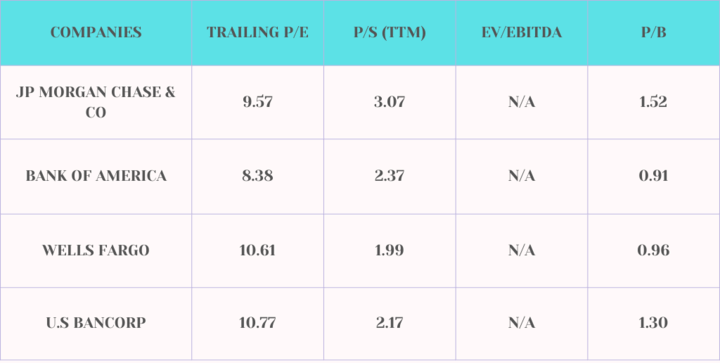
Compared to its competitors and based on its financial strength and performance, JPMorgan Chase & Co. is relatively undervalued.
JPM Stock Performance
Trading Information
Primary Exchange & Ticker: NYSE: JPM
Country & Currency: USA (USD)
Trading Hours: You can trade JPM stock in the Pre-Market (4:00-9:30 a.m. ET) and the After Hours Market (4:00-8:00 p.m. ET)
JPM Stock Splits: JPMorgan Chase has split its stock 4 times since 1982

Source: Motley Fool
JPM Stock Dividend: JPMorgan pays quarterly dividends of $1 per share which represents an annual dividend yield of 2.71%.
JPM Stock Performance since IPO
JPMorgan Chase is arguably the best-run bank in the United States with strong financials and good management. As a result, JP Morgan stock remains a favorite banking stock among investors who want to invest with reduced risk.
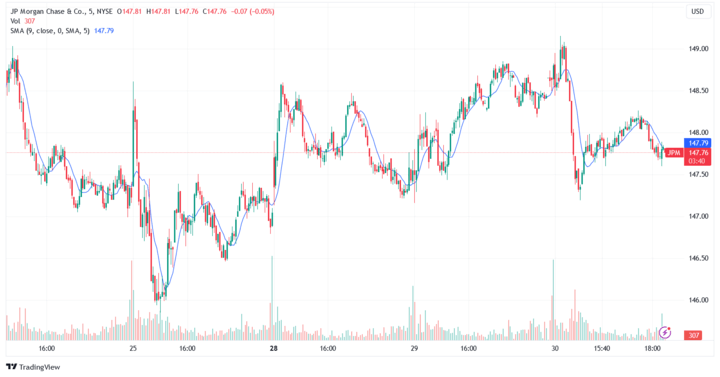
Since its IPO, JPM stock price has increased by 1445.47% and shows no signs of slowing down. The stock reached its all-time high of $171.78 in October 2021 and hasn't hit the same target since. The firm has established itself since the 2008 recession as a financial stronghold regardless of the economic condition. As one of the largest lenders in the United States, JPMorgan Chase & Co. benefits from high interest rates and an ever-growing portfolio of products and services. JPM stock price is also fueled by strategic acquisitions like Frank Financial Aid, Aumni, and InstaMed.
Trading at $148.16, JPM stock has grown by 9.62% mainly fueled by its unexpected Q2 2023 earnings report and the acquisition of First Republic.
JPM Stock Forecast
JPM stock has been doing fine so far but can it keep up the momentum? Analysts believe that it can. 27 analysts' ratings of JPMorgan Chase stock in the past 3 months places it as a Buy with a high estimate of $219 this year. However, if the trend does reverse and its stock price falls, it is projected to fall to $140.
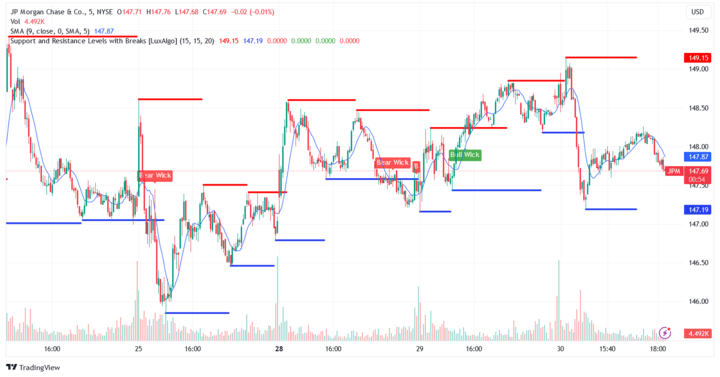
For now, there is a relatively stable uptrend with major support and resistance levels of $145.85 and $149.15 respectively. JPM Chase stock has broken the resistance level in the past month, reaching $158 in July and it may do so again following the release of Q3 earnings 2023.
Challenges and Opportunities
JPMorgan Chase & Co is a leader in the banking industry and its unique position opens up doors of opportunity while opening it up to institutional risks. Here are some threats and opportunities facing JPMorgan to consider:
Risks JPMorgan Face
- Strong Competition: JPMorgan Chase is well established in the financial services industry but it is a highly competitive one with various banks and financial institutions offering attractive products and services. Its strongest competitors are Bank of America, Berkshire Hathaway, Citigroup, U.S. Bancorp, American Express, and Toronto-Dominion Bank.
- Lack of trust in the banking system: After the failures of Signature Bank and Silicon Valley Bank, Americans' trust in the banking system declined significantly. Americans do not trust that their deposits are saved in banks, affecting how people view traditional banks like JPMorgan Chase. In the bank's latest report, total deposits dropped showing that customers are moving their money elsewhere.
- Controversies: A firm as large as JPMorgan Chase cannot avoid controversies no matter how hard it tries which has hurt the image of the company.

Source: Bloomberg
Growth Opportunities for JPM
- Strategic Acquisitions: As the largest bank in America by assets' size, JPMorgan has enough resources to go on a shopping spree, buying up smaller rivals. It recently acquired First Republic and Aumni and continues to buy fintech and digital banking firms to keep up with the competition.
- Leadership Position: The firm is a well-established player in the financial services industry meaning that it has a strong brand reputation and consistent financial stability in a competitive industry. In addition, it has a diverse product range to cater to customers regardless of their needs.
- Continued Growth: JPMorgan has had an earnings growth rate of 12.2% in the past 3 to 5 years despite its long-standing presence in the industry. Despite the current banking turmoil, JPMorgan still exceeded expectations and its earnings are projected to grow by 18.5% this year. JPMorgan Chase & Co is also focused on expanding its products and services to ensure that it continues to remain relevant.
What does the future hold for JPM?
As online banks, mobile banking apps, and technology continue to advance, JPMorgan is pouring resources to expand its reach. Its online bank Chase, will be expanded into European countries like the UK and Germany before the end of the year. But JPMorgan isn't focusing on Chase Bank alone. The firm has invested considerably in other lucrative online banks like Brazilian digital bank C6 and recently boosted its stake from 40% to 46%. At the same time, it plans on pouring $1 billion or more a year into AI to provide better services and boost customer experience.
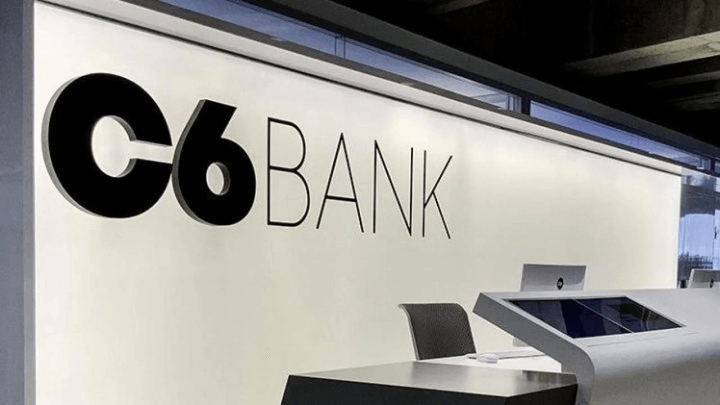
Source: BP Money
Although JPMorgan is expanding its online reach significantly, it still prioritizes retail branches to cater to local customers. So, over the next two to three years, about 130 branches will be opened throughout the United States and will keep expanding in China which it sees as one of its biggest overseas opportunities.
Why Traders Should Consider JPM Stock
JPMorgan Chase & Co. proves that in the banking industry, the rich only get richer. Its Q2 2023 earnings report was a display of financial resilience and it is expected to build on its strong performance in 2022 despite the financial uncertainty this year. The recent acquisition of First Republic also boosted investors' sentiment about JPMorgan's performance in 2023 and in the years to come. The deal is already showing a positive impact as JPMorgan gained $2.7 billion on the bargain purchase and close to $4 billion in revenue.
In addition, JPM stock has been less volatile than close to 75% of US banking stocks in the past 3 months and is currently undervalued based on its key metrics and balance sheet.
Trading Strategies for JPM Stock
- CFD trading: Traders who do not want to own JPM stock directly, can turn to CFDs as a way to make a profit. CFD trading allows you to speculate on the price movement of the stock by entering into a CFD contract with a broker. For example, if you predict that JPM stock is going to reach $200 by the end of the year, you can open a long CFD position and then sell when it reaches the price target.
- Trend trading: Trend trading is a simple yet powerful way to trade JPM stock. This trading strategy is based on the expectation that the trend will continue moving in the predicted direction. JPM stock is currently in an uptrend and is projected to remain so for 2023. In this case, you can open a buy position and watch your asset increase in value. However, if you believe the stock price is going to fall, you can sell your asset. But the market is unpredictable and it is necessary to use technical indicators to confirm the trend before making any decision.
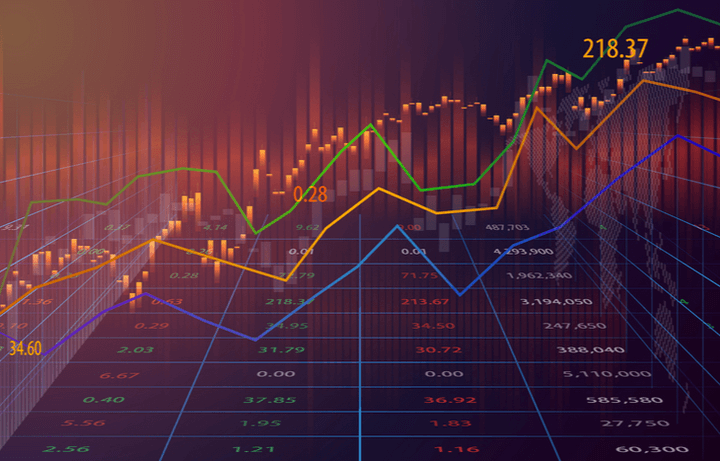
Source: Investment U
- Algorithmic trading: Algorithmic trading also known as algo trading or robot trading, makes use of computer programmes to make trades. The computer acts on a set of codes or algorithms imputed by the trader mostly to capture small price movements. In addition, these trading algorithms can be used to find certain technical or fundamental conditions to adopt in their trading strategy.
Trade JPM Stock CFD with VSTAR
Get a headstart in the CFD market by trading JPM Stock CFD with VSTAR. Built for both institutional and private traders, VSTAR offers lightning-fast order execution with low trading costs to maximize your profits and give you an advantage the minute you start trading.
With its educational content, podcasts, and trading tools, traders are given the resources to build on their knowledge and focus solely on becoming better traders.


Conclusion
JPMorgan Chase & Co has established itself as a force in the financial services industry and years of risk management paid off as it remained stable in the face of financial uncertainty this year. As technology improves, so does JPMorgan's potential for growth and it is continuously expanding into emerging markets to serve more customers.
Its financial strength, brand reputation, profitability, and diverse portfolio make it a good investment and one that you might want to consider adding to your portfolio.







